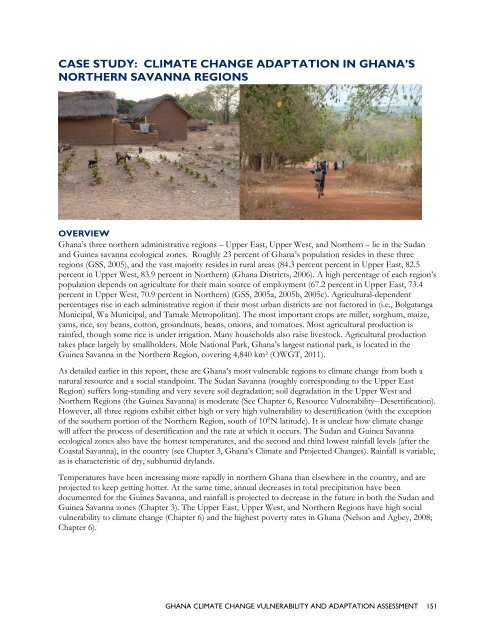ghana climate change vulnerability and adaptation assessment
ghana climate change vulnerability and adaptation assessment
ghana climate change vulnerability and adaptation assessment
- No tags were found...
You also want an ePaper? Increase the reach of your titles
YUMPU automatically turns print PDFs into web optimized ePapers that Google loves.
CASE STUDY: CLIMATE CHANGE ADAPTATION IN GHANA’SNORTHERN SAVANNAA REGIONSOVERVIEWGhana’s three northern administrative regions – Upper East, Upper West, <strong>and</strong> Northern – lie in the Sudan<strong>and</strong> Guinea savanna ecological zones. Roughly 23 percent of Ghana’s population resides inthese threeregions (GSS, 2005), <strong>and</strong> the vast majority resides in rural areas (84.3 percent percent in Upper East, 82.5percent inUpper West, 83.9 percent in Northern) (Ghana Districts, 2006). A high percentage of each region’spopulationdepends on agriculture for their main source of employment (67.2percent in Upper East, 73.4percent inUpper West, 70.9 percent in Northern) (GSS, 2005a, 2005b, 2005c). Agricultural-dependentpercentages rise in eachadministrative region if their most urbann districts are not factored in (i.e., BolgatangaMunicipal, Wa Municipal, <strong>and</strong> Tamale Metropolitan). The most important crops are millet, sorghum, maize,yams, rice, soy beans, cotton, groundnuts, beans, onions, <strong>and</strong> tomatoes. Mostt agricultural production israinfed, though some rice is under irrigation. Manyhouseholds also raise livestock. Agricultural productiontakes placelargely by smallholders. Mole National Park, Ghana’ss largest national park, is located in theGuinea Savanna in the Northern Region, covering 4,840 km 2 (OWGT, 2011) .As detailedd earlier in this report, thesee are Ghana’s most vulnerable regions to<strong>climate</strong> <strong>change</strong> from bothanatural resource <strong>and</strong> a social st<strong>and</strong>point. The SudanSavanna (roughly corresponding to theUpper EastRegion) suffers long-st<strong>and</strong>ing <strong>and</strong> very severe soil degradation; soil degradation in the Upper West <strong>and</strong>Northern Regions (the Guinea Savanna) is moderate (See Chapter 6, Resource Vulnerability--Desertification).However, all three regions exhibit either high or very high <strong>vulnerability</strong> to desertification (with the exceptionof the southern portionof the Northern Region, south of 10°N latitude). It iss unclear how<strong>climate</strong> <strong>change</strong>will affect the process of desertification <strong>and</strong> the rate at which it occurs. The Sudan <strong>and</strong> Guinea Savannaecological zones also have the hottestt temperatures, <strong>and</strong> the second <strong>and</strong> thirdlowest rainfall levels (aftertheCoastal Savanna), in thecountry (see Chapter 3, Ghana’s Climate <strong>and</strong> Projected Changes). Rainfall is variable,as is characteristic of dry, subhumid dryl<strong>and</strong>s.Temperatures have beenincreasing more rapidly innorthern Ghana than elsewhere in the country, <strong>and</strong> areprojected to keep getting hotter. At the same time,annual decreases in total precipitation have beendocumented for the Guinea Savanna,<strong>and</strong> rainfall is projected too decrease in the future in both the Sudan<strong>and</strong>Guinea Savanna zones (Chapter 3). The Upper East, Upper West, <strong>and</strong> Northern Regions have high social<strong>vulnerability</strong> to <strong>climate</strong> <strong>change</strong> (Chapter 6) <strong>and</strong> thehighest poverty rates in Ghana (Nelson<strong>and</strong> Agbey, 2008;Chapter 6) ).GHANA CLIMATE CHANGE VULNERABILITY ANDADAPTATIONASSESSMENT151
















